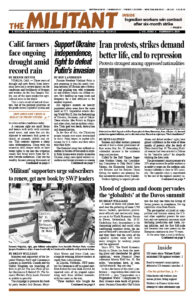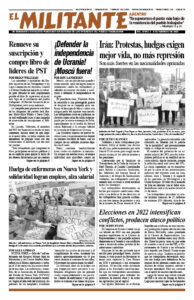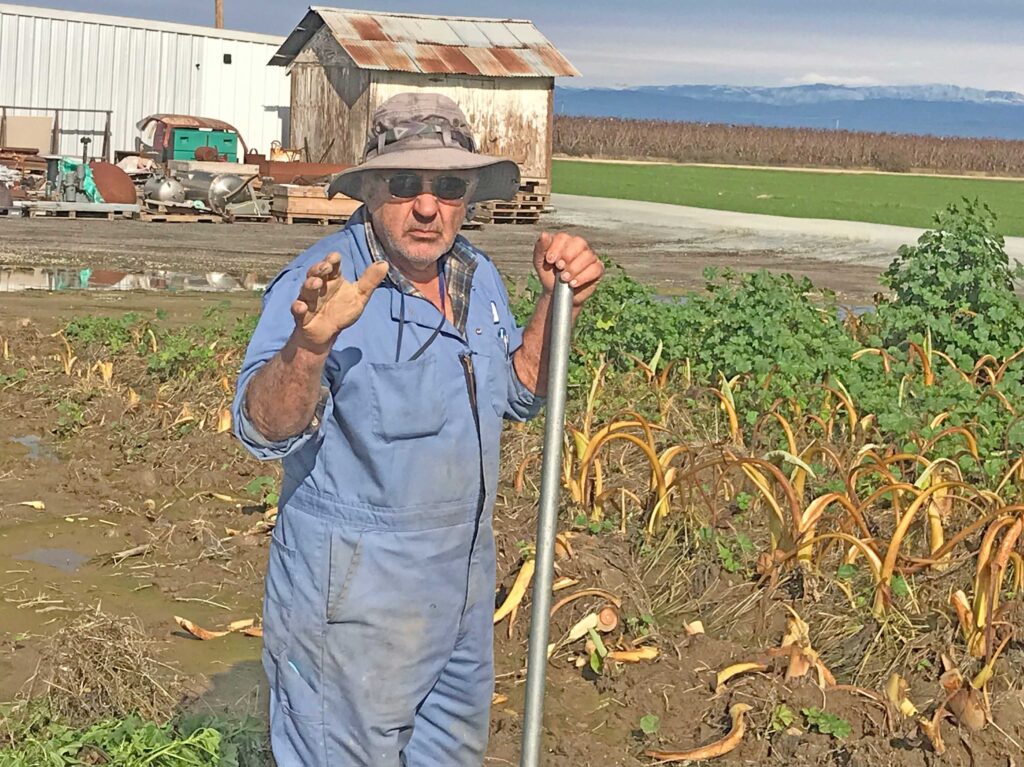VISALIA, Calif. — Three years of drought and now floods from heavy rains have had a severe impact on the conditions and livelihoods of farmers and workers in the San Joaquin Valley, one of the most productive agricultural areas in the world.
This is not a result of natural disasters, but of the political priorities of the profit-driven capitalist system and its crisis-ridden conditions today.
A common sight are small farms and homes with wells with contaminated water, and some that are dry adjacent to enormous lush green orchards of almonds, alfalfa and citrus. This contrast exposes a sharp class differentiation. Those with the resources drill deeper wells or have water rights to tap into the irrigation canals that bring water from the Sierra Nevada mountains. They are the wealthy farmers owning thousands of acres. It’s a different world for those who toil on a few acres of land, work in area industries or in the fields.
Sergio Caballos lives in Tooleville, an unincorporated community of a couple hundred in Tulare County. “The county delivers water to us since our well water is contaminated,” Caballos said as he was getting ready to go to his job as a truck driver hauling material in and out of farms. Pointing to the well down the block, he said, “That well ran dry last year. I think it’s less than 400 feet deep. Our problems started when two neighbor farmers drilled 800 feet and then we had no water.” Caballos explained that with rising costs his brother, who grows lemons on six acres, pays more for water than he gets in income from his crop.
Government admits water unsafe
A 2022 government audit of the State Water Resources Control Board reported, “Nearly a million Californians face possible long-term, negative health outcomes — including an increased risk of liver and kidney problems, as well as cancer — because they receive unsafe drinking water from a failing water system.”
Martín Jimenez, who lives on 16 acres west of Visalia, is a case in point. Nitrates from the cattle farm across the street have leeched into the groundwater. He gets by on 5-gallon jugs of water delivered by the county, and officials plan to place a filter for nitrates on his well.
Brand Vang sells greens he grows on five acres near Fresno at the Visalia Farmers Market. Last year his well ran dry and he had to drill a new one 300 feet down costing $37,000, he told the Militant. “I was lucky, because shortly afterward drilling prices sharply increased.”
“Over the past 10 years my well has dropped an average of six feet a year,” said Jim Van Foeken. He farms 30 acres of citrus in Ivanhoe. “One good rain doesn’t solve the drought and with inflation, the best scenario is I break even. You’re on the workers’ end of the squeeze and I’m on the farmers’ end of the squeeze,” he told me after I described the conditions factory workers like myself face today.
The San Joaquin Valley and the Sacramento Valley produce 25% of all food in the United States, as well as 40% of fruits and nuts.
The San Joaquin Valley is a semi-arid steppe where nearly 90% of surface water from irrigation canals and an underground aquifer is used for agriculture. The drought has forced farmers to increase pumping of the aquifer to irrigate crops. Ninety percent of valley residents also rely solely on water from the aquifer. Land subsidence due to a dropping water table is a mounting problem.
Frank Ferreira spent most of his working life breeding 5,000 cows on a nearby 3,000-acre dairy farm. Today he has a 30-acre farm west of Visalia growing wheat and corn silage. “The big guys want to screw everyone. They want to have the little guy give up,” he said. “They use water like crazy. They have three, four, five people filling out applications for water and they get 90% of it.” He explained that satellites monitor water evaporation rates and says plans are afoot to fine farmers with “excessive” rates.
Low pay, job cuts hit farmworkers
Thousands of farmworkers are now harvesting citrus and pruning trees. A dozen farmworkers, taking advantage of a day off because the fields were too muddy, were having a fish fry outside one of their homes.
One farmworker explained they work in almond orchards. When the temperature exceeds 95 degrees in the summer, they are sent home without pay. They get paid the $15.50 minimum wage, alongside confronting some of the highest unemployment rates of any metropolitan area in the country. Exacerbating the lack of jobs is the state’s decision to pay farmers $2.5 million to leave 531,000 acres unplanted last year.
Decisions of what cash crops to grow are determined by what can most profitably be marketed. Orchards of almonds and pistachios, primarily for export, fetch a high price these days and have expanded rapidly. Grape, alfalfa, and citrus farms are located next to large dairy operations. There are 20,000 farms in the San Joaquin Valley. Across the state more than half of all cropland is owned by 5% of farmers.
The J.G. Boswell Company farms 150,000 acres in California’s Central Valley. Along with Bill Gates and Ted Turner, Boswell is one of the 10 largest capitalist farm owners in the U.S. and uses his clout to monopolize access to water. In a 1989 interview Boswell vowed to “spend a lifetime defending” his control over this vital resource. Big landowners hold contracts for transporting much of the water from the Sacramento-San Joaquin Delta and own portions of the ditch companies that divvy up water from the King’s River and ferry it to farms.
The recent deluge of rain in California resulted in extensive flooding across the state. It also exposed the fact that for decades the government has done virtually nothing to build an infrastructure for flood protection, or dams and reservoirs to capture rainfall. The downpour “could have filled a reservoir the size of Yosemite’s Hetch Hetchy almost every 24 hours,” a Wall Street Journal editorial noted, Jan. 17. “Instead, nearly 95% of the Delta’s storm water this year has flushed into the Pacific Ocean.”


